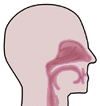  |
||
 |
June 2021Exosomes in Nasal MucusExosomes are small membrane sacs or vesicles produced and excreted from cells which may be secreted into nasal mucus. They are endogenous lipid nanoparticles. They are produced by all eukaryotic cells, are surrounded by a bilayer lipid membrane and range in size from 30-150 nm. This class of particles also includes microvesicles and apoptotic bodies. The contents of these particles include nucleic acids such as genomic DNA, various forms of RNA, proteins and lipids and carry information to and from other cells. They are found in every body fluid and serve as a natural cellular communication system. While they have been identified in blood serum and plasma, urine, cerebrospinal fluids, tears, and milk they have not been clearly identified in human nasal mucus or human saliva. We have studied the protein content and structure of saliva (1) and nasal mucus (2). Because of these studies we have been able to identify characteristics of these fluids in normal subjects and in patients with taste and smell dysfunction. With these analyses we have identified biochemical moieties missing or decreased in patients with taste and smell dysfunction. In saliva we have identified decreased gustin (1) or carbonic anhydrase-6 (3). With increased levels of this moiety taste function has returned to or towards normal levels (4). In nasal mucus we have identified decreased levels of cAMP, cGMP and sonic hedgehog (5, 6). With increased levels of these moieties taste and smell dysfunction has returned to more normal levels (6). We have not identified exosomes in either nasal mucus or saliva. What changes are present in these particles in patients with taste and/or smell dysfunction and how this information can be used to evaluate and treat these patients is presently unclear. References
|
|